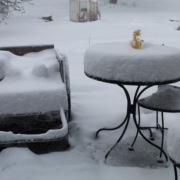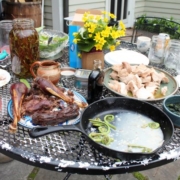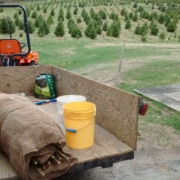Mid-May Snow
Folks who live in the Valley of Vermont woke up to 8 inches of snow this morning. Snowfall totals in the mountains will undoubtedly be higher. We’re not sure what the snow and accompanying cold is going to do to the trees, which have tender new leaves on them. Or to the wild animals who are preparing to raise, or are actively raising, their young of the year.
We did a quick scan of weather records to see how unprecedented a snow like this is. In Burlington, there have been only four May snow events of over an inch since they started keeping records in 1892. The deepest was 3.7 inches. Parts of western Massachusetts and central New York got a significant May snowfall like this one on this exact date in 1977, but most of Vermont picked up only a trace to 2 inches in that storm.
Suffice it to say, snowfall totals from this storm will be unprecedented in a lot of southern Vermont towns. The accompanying cold is predicted to break records as well. We’ll watch closely and try to record how it all plays out.
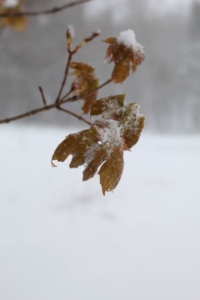
Snow and ice adorn a tender new leaf.
Cooking Wild Turkey
Most people with young children are on full-time childcare duty these days, and so besides figuring out how to get work done, they’re figuring out how to entertain and hopefully educate their kids. My partner and I are in this boat, as is my brother and his wife. And so this week we took the kids out to collect food for a wild feast. The activity checked a lot of boxes, not the least of which was letting us put our energy into something productive and reverential that we might not have had time for pre-COVID.
You can see the remnants of the meal in the picture above. We opened things with shots of chaga-infused vodka. (Jelly jars full of violet-syrup-infused rhubarb juice for the kids.) We then feasted on freshly-procured wild turkey (with trout lily and toothwort garnish), sautéed fiddleheads and nettles, potato leek salad and latkes. For desert with had meringues drizzled with violet syrup and mugs of black birch tea. All in all it was a great success.
I don’t feel like I have any particular expertise to share where it comes to preparing the vegetable, flower, and fungal portions of the meal. If you’re new to foraging, you can find recipes ranging from decent to great online for almost any of this. If you simply substitute leek for onion and blanched nettles for spinach and fiddleheads for asparagus in your go-to dishes, you’ll be fine, too.
I do feel like I have some hard-won knowledge regarding wild turkey, though, which I’ll share. For years I tried, like a lot of people do, to cook it like a domestic bird. But this is the oldest mistake in the book. Some swear by tricks that let you get around this – like flipping the whole bird upside down as you cook it – but they’ve never worked for me. The breast meat is so lean, and the thighs and legs so sinewy and laced with tendons that are bone-hard, that I can’t see a way around treating the cuts separately. If you don’t, you’re going to have cooked breast meat and iron legs, or edible legs with shoe-leather breast meat.
Even when you recognize this, though, you’ve got to be careful. I’ve still had birds end up rubbery after separating and fussing and braising the meat low and slow.
I nailed the turkey in the picture above, and here’s how I did it.
Step one was a brine. My go-to-recipe is 3 quarts of water, ¾ cup kosher salt, 1.5 cups soy sauce, 2 cups brown sugar, 1 cup maple syrup, 3 heads garlic, 2 hands ginger, hot pepper flakes, and whatever herbs I’m feeling in the moment. But feel free to experiment. Heat the brine to a simmer and stir to dissolve the salt and sugar. Then cool to room temp before submerging and then refrigerating the bird. If you remove the backbone from the carcass, and separate the thigh/leg portions from the breast, you can fit a big tom into a three gallon crock, which will easily fit in a fridge.
When it was time to cook things, I separated the breast meat from the carcass and the legs from the thighs. I drizzled the carcass with oil and put it in the oven to brown for about an hour – I’d use it later for soup. I took the thighs and legs and put them in a large braising pot, then poured the brine in until the meat was just submerged. All this liquid didn’t feel right to me – one of the rules of braising is you don’t want to drown the meat. But I drowned it, just like it was beef stew. I then simmered it for about 3 hours. I then removed the meat, shredded it, and put it in a casserole dish with some schmaltz (chicken fat) I had in the freezer. (To make schmaltz, next time you cook a chicken, render the fat, pour the liquid into a canning jar, and throw it into the freezer.) I then let the shredded turkey meat crisp up in the chicken fat for about 15 minutes in a 450 degree oven. If you’ve ever made pork carnitas, it’s the same technique.
The breast meat I poached, using the same brine bath I cooked the dark meat in. The deal with poaching is that you do not want the liquid to simmer. You want it to be around 160 degrees. It took about an hour to cook. While the breast meat poached, I made a simple pan gravy.
The results were spot on. Crispy chewy dark meat and moist, succulent breast meat. The two textures complimented each other. My brother, having been subjected to rubbery wild turkey over the years, sheepishly brought hot dogs over for the kids, just in case the turkey didn’t come out. They’re still sitting, unopened, in the fridge.
Cookbook author Hank Shaw, who maintains a fabulous online game-meat cooking archive, was the one who inspired me to try these cooking techniques. The original source of my brine recipe has been lost to time.
Man and Machine
When you get up to the tree, your instinct is to grab the trunk with the clam, but if you’re holding it, the saw will bind. You’ve got to cut the tree and then close the clam almost simultaneously. If you’re off, the tree can fall back and land on the machine.
Once the tree’s cut and you’ve got a hold of it, you need to move it to where you want to lay it. Remember in little league when they showed you how to balance the bat in your hand? (He demonstrates.) You need to find the balance point of the tree.
It takes a while to get the hang of it. It takes more brains than balls.
— Greg Haskins
We’re having some logging done this spring, which is not a phrase that an ecologically-sensitive person is supposed to utter. The ground in April is wet, of course, which can lead to ruts and unnecessary soil disturbance. The bark on the growing trees is getting loose, as the sap flows and the trees move into high-gear making leaves; this means that the trees left standing are more vulnerable to injury than they are in winter, when they’re dormant.
And yet technology, and the right logger, is allowing us to push back on this conventional wisdom.
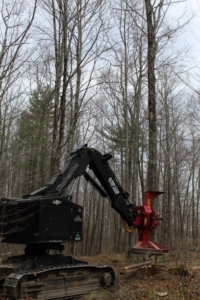
The machine in this picture is an 80,000-pound feller buncher. (To put that weight in perspective, the cutting head – just the cutting head – weighs as much as my full-sized pickup.) And yet it’s tracked, so the weight is distributed better than a skidder with four big tires. And as it cuts, it lays down brush and poles where needed to further cushion the ground.
The operator, pictured above, is Greg Haskins, who works for Hunter Excavating in South Londonderry, Vermont. Picture him deftly moving the beast through the forest, reaching out with the boom to cut the marked trees; bear-hugging, balancing, lifting them, then moving them and setting them down in a way and in a place where they won’t disturb the standing trees. You can see from the picture below the work he did. No gashes on any of the crop trees. (This is destined to become part of a sugarbush, if you’re wondering why the crop trees are marginal-looking red maple.) No jagged crowns. Minimal soil disturbance.
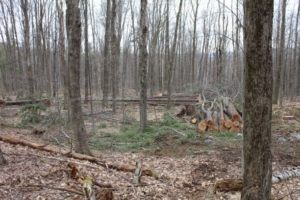
People like me – it might be safe to say people like us – tend to distrust technology, especially big, loud, imposing technology. And to be fair, there are applications where you can watch a feller-buncher mow through a forest and get chills. But when they’re used thoughtfully, and wielded skillfully, it’s hard to be nostalgic for the old chainsaw and cable-skidder method, which was crude at best. As I watched Haskins work, I marveled at how fast, and efficient, and clean the work was.

